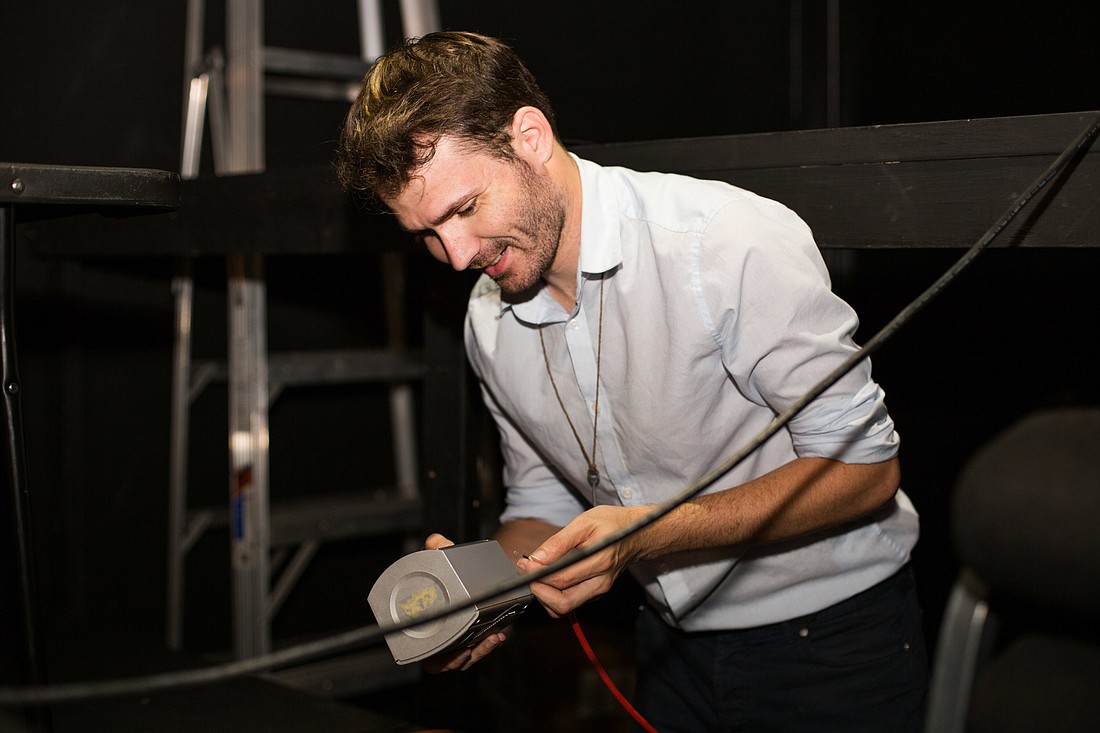- July 26, 2024
-
-
Loading

Loading

What does a theatrical sound designer do? Right now, the acrobatic Alex Pinchin is climbing into a narrow nook at the back of the Urbanite Theatre. During performances, this space is closed. It’s open now, revealing a tangle of wires resembling the guts of an old-fashioned TV set. There’s not enough room to stand, so Pinchin hunkers down like a skinny Humpty Dumpty. He sits in the alcove for about a minute, head turned down, as his deft hands secure a data line. During the next play, that line will feed audio files to a concealed speaker. Does it work?
Pinchin climbs down, walks behind a table, and presses a key on a laptop computer. The theater instantly fills with the syrupy “Theme from a Summer Place.”
Yes, it works.
That simple connection is only a small part of a sound designer’s job.
In live theater, they’re responsible for everything you hear. Their audio artistry encompasses gunshots, ambient background noise, recorded music, live music, clanking machinery, twittering birds, the hubbub of a crowded restaurant, the honks of a traffic jam, sirens, the cacophony of a carnival, the shouts of an angry mob, or …
Any sound you can imagine. And sparking your imagination is what it’s all about.
Because sound can create a world in your mind’s ear.
A set designer can invent a visible environment, but it’s clearly limited to the stage. A soundscape has no limits. Your mind imagines what it can’t see. Without even knowing it, you’ve just been enlisted as a world-builder. But only if the sound designer’s good at their art.
And Pinchin must be good. Right now, he’s flooding the theater with the sound of torrential rain. It’s amazingly convincing … No, wait. It’s actual rain.
“Would you mind turning that down?”
He laughs.
And then — with perfect, spooky timing — the deluge becomes a sprinkle. I let Pinchin get back to work. Outside, I’m suddenly more attuned to every sound I hear.
The next voice I hear belongs to Brendan Ragan, Urbanite’s co-artistic director. His knowledge of sound design isn’t second-hand. He typically creates the sonic environments for the plays he directs.
“So, you don’t have a full-time sound designer?”
“Some theaters do. But not the Urbanite.”
Ragan explains that big theaters with big budgets can hire full-time sound designers, or even an additional sound engineer to handle the devilish technical details. Urbanite makes do with a network of multitasking talent. Pinchin is part of that network. His credits include “Pilgrims,” Incognito,” and this month’s “Wakey, Wakey.”
“I assume there’s no sound engineer to back him up?”
“No. It’s all on him. At Urbanite, the sound designer is the engineer.”
According to Ragan, their invisible artistry is often overlooked. When their tapestry of sound brings a theatrical dream to life, the director usually gets the credit. What if the dream becomes a nightmare?
“That’s the magic and terror of live theater. You can always expect the unexpected. When it happens, you have to stay in the moment and make it work.”
— Brendan Ragan
“Sound designers are like ninjas,” Ragan says. “When everything goes right, they’re invisible. You only notice them when something goes wrong.”
And if anything can go wrong, it will.
Live theater is not exempt from Murphy’s Law, as any sound designer can tell you.
Sound effects depend on sound equipment. And fallible human beings. Actors trip over cords and forget their dialogue; technology fails all by itself.
“That’s the magic and terror of live theater,” Ragan says. “You can always expect the unexpected. When it happens, you have to stay in the moment and make it work.”
Urbanite’s sound designers all have their war stories.
Pinchin recalls a production of “In the Heights” at the University of Florida. “It’s Lin-Manuel Miranda’s first musical,” he says. “On a technical level, it’s very demanding. We had 12 actors, all mic’d up. We came up to a pivotal song. This supposedly happened during a citywide blackout, so we cut the lights. We started the song track and it died. Without missing a beat, the entire cast kept singing a capella.”
He laughs.
“People congratulated me afterward,” he says. “‘Wow! I loved what you did in the blackout scene.’ They thought I’d done it on purpose. But if I had, I could’ve never pulled it off.”
Rew Tippin’s Urbanite soundscapes include “Reborning,” “Northside Hollow” and “Women Laughing Alone with Salad.” He’s had his own run-in with the sounds of silence.
“I once had a snafu in a production of ‘What the Butler Saw,’” he says. “We couldn’t use a real gun, so we played a recording of a gunshot over the sound system. One night, the system crashed. After a beat or two of dead silence, the poor actor pointed the gun and went ‘Bang.’ Based on the play, the audience probably thought it was deliberate silliness, but I was mortified.”
But forget these hiccups. Pinchin and Tippin have plenty of peak experiences. For Pinchin, that includes the haunting melody on a broken piano he recorded for “Incognito.” Tippin is still proud of the impressionistic, sonic breadcrumbs he created for “Women Laughing Alone with Salad.”
Ragan says intimate theater has creative advantages.
“We’re a small space, so we don’t have to mic the actors,” he says. “Microphones are always trouble.” He adds that a sound designer typically collaborates with the music director. But Urbanite hasn’t staged any musicals. The songs you hear are the sound designer’s choice. They’re the one-person band in charge of recorded playback.
“Artistic limitation always pushes you to do your best work,” he says. “At the Urbanite, we have some of the best sound designers around. They’re so good, people forget they exist.”
Next time, don’t forget. The next play you experience, listen carefully. Be aware of this invisible artform — and tune into the sound designer’s audio artistry.
These sonic ninjas deserve a second hearing.